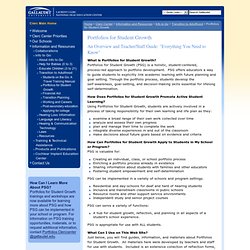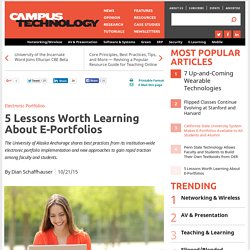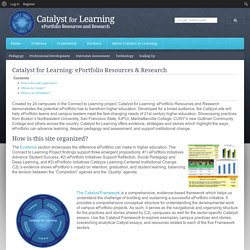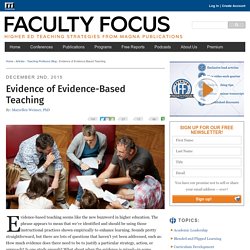

ePortfolios. Portfolios: More than a file folder. Portfolios for Student Growth. What is Portfolios for Student Growth?

Portfolios for Student Growth (PSG) is a holistic, student-centered, process-led approach to portfolio development. PSG offers educators a way to guide students to explicitly link academic learning with future planning and goal setting. Through the portfolio process, students develop the self-awareness, goal-setting, and decision-making skills essential for lifelong self-determination.
How Does Portfolios for Student Growth Promote Active Student Learning? Using Portfolios for Student Growth, students are actively involved in a process of taking responsibility for their own learning and life plan as they: examine a broad range of their own work collected over timeanalyze and assess their own progressplan and manage their time to complete the workintegrate diverse experiences in and out of the classroommake decisions about future goals based on evidence and criteria.
ePortfolio Step-by-Step Process - ePortfolios with GoogleApps. Students: (Optional) Use a simple table or GoogleDocs Spreadsheet to list the artifacts, and assign (classify) each one to the outcome/goal/standard that the artifact will demonstrate.

Use the table to keep track of artifacts that might be stored on one of the many Web 2.0 sites that you could use to store your work. See Dr. Barrett’s portfolio for an example (Artifacts in GoogleDocs Spreadsheet).Recommendation: Students: convert all attached artifacts into web-compatible formats (JPEG or PDF) so that the potential reader will not need to own the original software in order to read it (i.e., Microsoft Office, Publisher, Inspiration documents could easily be converted into PDF and attached to a blog entry, or link to GoogleDocs).
Web 2.0 storage: Video files can be saved on one of the video sharing sites, and use the Hyperlink or Embed code to include in your blog entry. Word, Excel and PowerPoint files could be uploaded into GoogleDocs. Paragogy and Heutagogy. 5 Lessons Worth Learning About E-Portfolios. Electronic Portfolios 5 Lessons Worth Learning About E-Portfolios The University of Alaska Anchorage shares best practices from its institution-wide electronic portfolio implementation and new approaches to gain rapid traction among faculty and students.

By Dian Schaffhauser10/21/15 The University of Alaska Anchorage introduced e-portfolios to the campus in a big way this year, rolling out the technology across the entire institution. And as anyone who has attempted such a feat quickly realizes, large-scale e-portfolio adoption takes more energy and commitment than the typical technology project. Catalyst for Learning: ePortfolio Resources & Research. Created by 24 campuses in the Connect to Learning project, Catalyst for Learning: ePortfolio Resources and Research demonstrates the potential ePortfolio has to transform higher education.

Developed for a broad audience, the Catalyst site will help ePortfolio teams and campus leaders meet the fast-changing needs of 21st century higher education. Showcasing practices from Boston’s Northeastern University, San Francisco State, IUPUI, Manhattanville College, CUNY’s new Guttman Community College and others across the country, Catalyst for Learning offers evidence, strategies and stories which highlight the ways ePortfolio can advance learning, deepen pedagogy and assessment, and support institutional change.
The Evidence section showcases the difference ePortfolio can make in higher education. Volume 5 - Number 2 - 2015. Evidence of Evidence-Based Teaching. Evidence-based teaching seems like the new buzzword in higher education.

The phrase appears to mean that we’ve identified and should be using those instructional practices shown empirically to enhance learning. Sounds pretty straightforward, but there are lots of questions that haven’t yet been addressed, such as: How much evidence does there need to be to justify a particular strategy, action, or approach?
Is one study enough? What about when the evidence is mixed—in some studies the results of a practice are positive and in others they aren’t? In research conducted in classrooms, instructional strategies aren’t used in isolation; they are done in combination with other things. Questions like these should prompt more cautious use of the descriptor, but they don’t excuse us from considering the evidence and how it might be incorporated into the teaching-learning activities of our courses. Here’s a sampling of actions from the 21 that appear on the PORTAAL instrument. Portfolio Evidence-Based Learning (PEBL) Portfolio Evidence-Based Learning (PEBL) I’ve written a number of blogs related to the ongoing AAEEBL/EPAC/AAC&U/IJep webinars to define the eportfolio idea.

In these blogs, I have been struggling, as we all have for years, to best describe what we do, what we believe, and what we are. A number of people are beginning to think the term “eportfolio” itself may be the problem. In this blog, I found myself agreeing. Straining to Define “ePortfolio” The effort to define “eportfolio” as a model of learning is impaired by naming a learning idea after a technology. General Misunderstanding of “ePortfolio” But, to the mass of educators around the world, the term “eportfolio” evokes a technology. Secondly, it is very hard to define a learning theory implied by “eportfolio.”